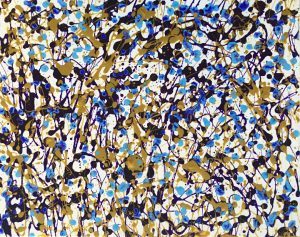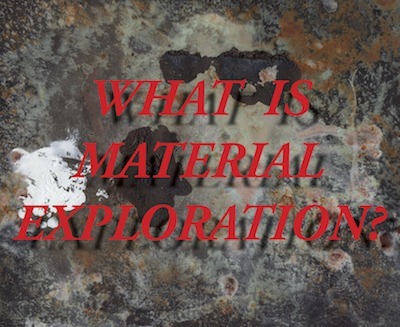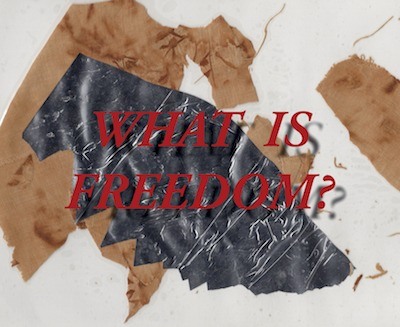by Nickolas Calabrese

There are two dogmatic justifications (or really non-justifications) that are provided time and time again when discussing the production of abstract art. First is ‘material exploration’, and second is ‘freedom’. If you have ever contemplated certain abstract artworks with skepticism, rest assured that your incredulity is not crazy. Even if the work has been accepted and defended by respectable critics, there is a profoundly problematic reasoning employed in the defense of a good portion of what I will call for present purposes dogmatic abstraction. This text will address what counts as weak justification for abstract art, as well as why justification in art is essential for understanding it at all. Justifying artworks is equivalent to having an alibi – it is the only good reason why the artist isn’t lying. It is the basis from which we can discern good from bad art.
The problem with speaking about art dogmatically is that it becomes an assumption, something taken for granted as true without proper interrogation. When reasons are supposedly beyond critique, then the artwork in question is bulletproofed. Providing and obtaining reasons in the artworld is something that is almost holy – it is a leap of faith because art usually has no precedent save for other artworks. Formally an artwork requires reasons because it did not exist hitherto and has no use until the maker wills it. Accordingly, the consecrated act of providing and receiving reasons – of justification – is what is at stake when dogma is offered instead of a shrewdly thoughtful account. These two dogmatic suppositions are not just false in general but false in detail.

First dogma: ‘The Argument from Material Exploration’. Material exploration seems to have a variety of meanings. It is first and foremost a term denoting a particular type of propaganda (for instance here or here). Whether it is uttered in art schools, in art fairs, in monographic catalogues, etc., it is a common refrain meant to imply that the author of the work is using abstraction as a means of exploring the physical properties of materials (a logically valid description to be fair). Unpacking that, it becomes clear that what the aim of material exploration is: to see what stuff does, physically, when it interacts with other stuff. This is the meaning of experimentation. Material exploration is ultimately an experiment in seeing what materials can do when they mix together. Now, unlike the purpose of experimentation in the sciences (theoretical, physical, social), the experiments in abstract painting, for example, will never yield usable information, apart from some solipsistic understanding of paint or other art media. There is no usable knowledge to be derived from an artist’s explorations and is not worth its salt as such. Material exploration has some value, of course, in such areas as ecology, theoretical physics, biology, etc. But to claim that it has worthwhile application in art making is the suggestion of a crook.
The byproducts of material experimentation are usually trivial. They either look good, bad, interesting, bleak, and so on, but they are not, to borrow a phrase from Arthur Danto, the embodiment of meaning – material experimentation has to do with aesthetics, the looks of a thing, and the content is different, even if it is enhanced by the visual appearance (which it should be). If anything, an artist’s material explorations ought to be research towards making good art, and not the final product. Imagine Proust’s notes and outline taking the place of his finished novel Swann’s Way; or the screen tests of all of the actors from De Palma’s Body Double showed up on the screen rather than the psychosexual thriller we expect.
Experimentation is valuable because it is supposed to lead to a destination. This is not to say that the exploration of materials is uninteresting, let alone unnecessary. Discoveries made in the reverie of materials is essential to pushing the envelope of what art is and what art can be in the future – this is one of its excellences. But residing in these dogmatic slums invites unoriginality and provokes bored-to-death criticism. These explanations don’t count because they offer the process through which the thing was made up as justification of why a thing was made. They might not have realized that the idiom “the journey is the destination” is just a turn of phrase, and that there still must ultimately be some destination in mind, even if the journey coincidentally takes the place of the destination because it reveals something worthwhile. The notion of making something just to see what happens with the physical stuff is – at best – boring. At worst, it is a perversion of something that people in the same business work very hard at, giving all of their mental and physical energy toward enrichment of the genre to its fullest.
Worth noting is that the argument from material exploration is in no way limited to abstraction, yet that argument is usually invoked in reference to abstraction. It should be prima facie true that material explorations can be accomplished in figurative art just as easily as abstraction. An artist can make any kind of image with any kind of material. But artists who have the mimetic impulse and also engage in experimentation with materials are less inclined to publicly justify their work as acts of material exploration, and indeed almost never do, at least not to this author’s mind. This is probably because they have other evidence to back up the why’s of what they have done. More importantly, it is also because they understand that it is just entailed by the job, and not the entirety of the job (and it is just a job). This prompts a puzzling situation wherein two types of artist, the figurative and the abstractive, can both be engaged in similar working processes, and for one it is just a fragment of the why question, and for the other it is the complete answer to the why question. For these reasons the argument from material exploration is a problematic foundation upon which to stand as an artist.
 Second dogma: ‘The Argument from Freedom’. The issue of freedom in abstraction is more nuanced than the argument from material exploration. But first it should be explained what is actually being referred to when speaking of freedom in the practice of making art. It refers to the sense of being untethered, of being released from the manacles of figurative depiction. Abstraction, for these folks, is supposed to be a way out of the circularity of depicting the staid object of reality endlessly. Freedom is autonomy. Autonomy is acting without hindrance of any governing bodies. Depicting abstraction is supposed to be ungoverned. This is a charmingly saccharine take on how abstract art can be made. But it is dramatically unsophisticated. This type of naivety is knotty due to its misunderstanding of freedom and its good uses. Freedom to participate in the most leisure of leisure classes is not a good use of freedom: it betrays good taste as well as a robust intellectual life. (One might as well only make abstract paintings on Sundays if one’s primary reason is for freedom).
Second dogma: ‘The Argument from Freedom’. The issue of freedom in abstraction is more nuanced than the argument from material exploration. But first it should be explained what is actually being referred to when speaking of freedom in the practice of making art. It refers to the sense of being untethered, of being released from the manacles of figurative depiction. Abstraction, for these folks, is supposed to be a way out of the circularity of depicting the staid object of reality endlessly. Freedom is autonomy. Autonomy is acting without hindrance of any governing bodies. Depicting abstraction is supposed to be ungoverned. This is a charmingly saccharine take on how abstract art can be made. But it is dramatically unsophisticated. This type of naivety is knotty due to its misunderstanding of freedom and its good uses. Freedom to participate in the most leisure of leisure classes is not a good use of freedom: it betrays good taste as well as a robust intellectual life. (One might as well only make abstract paintings on Sundays if one’s primary reason is for freedom).
Aside from this mostly subjective criticism (viz. about what a good use of freedom looks like), there is a major flaw in the logic of the freedom argument; namely that it is nonsense. True abstraction holds no cue, no definitionally sound position. It is intentionally meaningless since it steers clear of language and nature in priniple. Literally meaningless because abstraction is not found in nature (otherwise it is not abstract, duh), and since meaning is socially constructed it cannot be found in abstraction. This begs the question of how freedom is to be found in meaninglessness. The idea of meaninglessness alone is full of existential dread, unless of course you are not a part of the linguistic world, like babies, aliens, people with severe developmental disabilities, etc. The fact that abstraction is meaningless makes the alleged freedom that some associate with its creation arbitrary. Abstraction can be as much about freedom as it can be about bondage, requiring no forays into critical studies, let alone understanding what the words freedom and bondage themselves mean. Abstraction can be as much about freedom as it can be about clipping toenails!
If the premise is invalid, then the conclusion (the artwork itself) is likewise invalid. Freedom may seem like a convenient explanatory fact for making abstract art – but it is a gross failure of reason. The second dogma, freedom, received one of its most spirited defenses in Moholy-Nagy’s aptly titled “In Defense of “Abstract” Art” (1945). He stereotypically supported the argument for abstraction being derived from freedom, “freedom from the imitation of nature and the philosophy connected with it.” The problem here is that, as has already been noted, this doesn’t mean anything! Consider the following conditional statement: if John is a bachelor, then he is unmarried. That is a perfectly valid and true sentence. Now consider the following: if John has hair on his head, it’s going to rain in Tahiti. The truth as well as the validity is equivocal since the opposite can be just as true. Neither true nor untrue, this justification is rubbish.
Providing justification is essential in human life. Science, religion, philosophy, the arts: all of these fields are exclusively engaged in coming up with reasons for why things are the way they are, and, as a normative bonus, how we should proceed in accordance or discordance with those reasons. The normativity of the question – what we ought to believe – is at the heart of justification. When Kant wrote his famous line “thoughts without content are empty, intuitions without concepts are blind,” he had this in mind. He wasn’t saying that there is some new category of thoughts that don’t have content. He was saying that thoughts without content aren’t thoughts at all. Likewise, perceptions that lack conceptual structure are rendered unintelligible. The notion of thoughts without content should sound familiar in this context – abstract artworks without sensible justification can be understood analogously. That perceptions without concepts are blind should also look familiar – the perception of abstraction, the lack of recognizable structure, blindly reaches out for meaning in the abyss. Ideas are what should be at the very core of art.
The problem (and perhaps the virtue) of abstract art is that, at its most basic level, you are forced to take the artist’s word at face value. Whatever the artist says about it is indisputable because of the aesthetic solipsism that is inherent in visual art. This is why if one is going to have a row over abstraction on grounds other than “it’s ugly” (which plenty are) then the rules and independent reasons of the form are what need to be challenged. An abstract cabal has long held court with specious reasoning. A sound justification is the most potent adversary for lazy artists wanting to phone-in their artworks. Kant’s epistemological aim in the Critique was to demand reasons as the chief sufficient condition for understanding our place in the world. But truffling for reasons proves near impossible when one is blinded at the start by explanations chock full of dogma. Justifications are what make the world meaningful – without them all that’s left is gibberish.
This text is not against Abstraction in general. You should not be categorically distrustful of abstraction – there are cases where it works well (Anni Albers’ craft-based abstractions addressing gender and labor); cases where it works very well (Charlotte Posenenske’s deadpan postindustrial sculptures); and cases where it works splendidly (Hilma af Klint’s paintings bending dimensions of space and time to meet a spiritualized end). It should be evident that this text is against just two out of a manifold of specific reasons for making abstract art. However, it is worth noting that those who make great work are often lumped in with their peers who engage in formally similar/conceptually dissimilar work, which can bastardize the form itself. At least part of the problem is in the willful production (or reproduction) of abstraction that looks like other abstraction. This is the adoption of formal characteristics with no rationality leaving only a soulless shell without definite characteristics, other than looking the part.
All of this poses an exceptionally broad question: if not art as a strategy in procuring freedom, if not art as an exploration of materials, then what should art be? A brusque, straightforward answer to this exacting question would injure its reputation, but who cares? In a nutshell, the ideal artwork is formally inventive and intentionally thoughtful. But to paraphrase a brilliant remark from Hilary Putnam: any theory that fits in a nutshell belongs in one. Strictly speaking it is only the starting line to an open ended definition. Making things that are new and thoughtful is not easy, but that is precisely what this text is predicated upon – it is difficult to make good art. Making dogmatic artwork is an impoverished way of escaping the toilsome task of thought.
